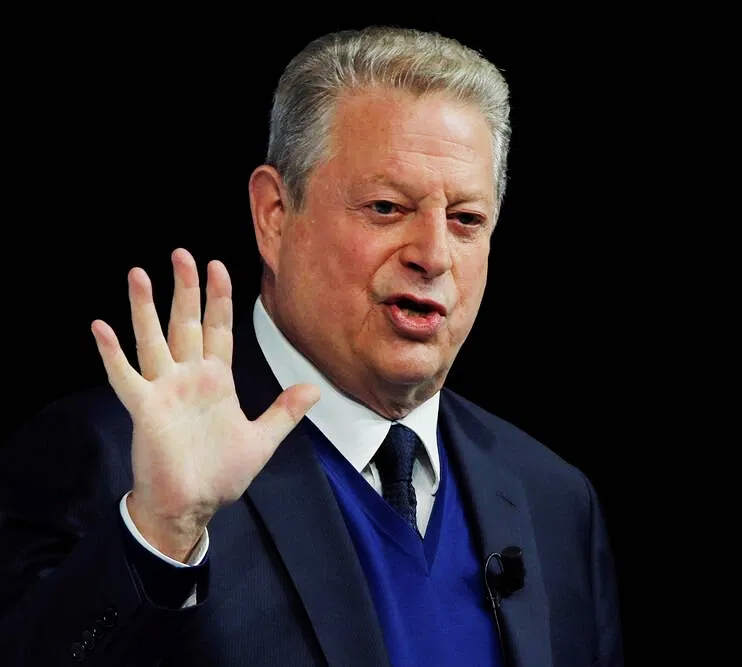(Thomson Reuters Foundation) – As the frequency and ferocity of extreme weather events from wildfires to floods grows, the U.S. public is becoming more concerned and ready to act on climate threats, former U.S. Vice President Al Gore said.
“The world, and the United States, are crossing the political tipping point on climate right now,” the Nobel peace prize laureate told the Thomson Reuters Foundation on the sidelines of a three-day conference on climate and food systems.
“The next few years will be characterized by the largest investment boom in sustainability-oriented technologies – including regenerative agriculture – that the world has ever seen,” he predicted.
The U.S. presidential election next month will be “enormously consequential for not only the United States but also for global climate policy” as countries battle to hold the line on planetary heating, he said.
Former Vice President Joe Biden, Republican President Donald Trump’s Democratic challenger, has said he would ensure the United States moves to 100% clean energy and reaches net-zero climate-changing emissions no later than 2050.
Trump, in turn, has promised to remove the United States from the Paris Agreement on Climate Change the day after the election and has been a strong supporter of fossil fuel energy companies.
But Gore said that as the price of clean energy drops, shifting market forces are likely to drive a continued push toward renewables.
“The rate of coal burning has declined even more rapidly under Trump, in spite of his pledges to the contrary, than the changes that occurred under President Obama,” Gore said in a telephone interview.
The “sustainability revolution” that is now underway is “the largest transition the global economy has ever gone through,” he said.
“We’re in the early stages of it now but this will have the magnitude of the industrial revolution combined with the speed of the digital revolution.”
SMARTER FARMING
Gore’s optimism is buoyed in part by promising results from his own efforts to capture and store climate-changing emissions on his nearly 700-acre Tennessee family farm, which grows vegetables and chestnuts and raises animals.
The “regenerative agriculture” techniques used on the farm focus on improving the health of the farm’s soils, which allows them to hold and store more carbon.
Scientists say soil stores more carbon than the planet’s atmosphere and vegetation combined – but that the highly fertile and carbon-rich top layer of soil is fast eroding worldwide due to human activities including intensive agriculture.
At Gore’s Caney Fork Farms, however, shifts in farming systems have allowed the land to sequester about 880 tons of carbon dioxide – the main greenhouse gas heating up the planet – each year for the past five years, he said.
This is equivalent of offsetting the consumption of 100,000 gallons of gasoline each year, the former vice president said.
“That’s a tiny amount in one way – but it’s five times as much carbon as we had been sequestering up until the transition to regenerative farming techniques,” said Gore, a longtime environmental activist.
Changes on the farm include rotating crops, planting trees among field crops and reducing plowing and tilling, while maintaining harvests.
If such techniques became more widespread, U.S. farms could store “an enormous amount of carbon”, Gore said.
RISING DISASTERS
He said he is encouraged by polls and other data showing more Americans are concerned about climate change and want action on it.
A New York Times poll published last Tuesday showed 66% of Americans favor Biden’s proposed $2 trillion climate action proposal and only 26% opposed it.
“You just don’t get numbers like that on a $2 trillion proposal unless there is a major change in public opinion from a few years ago – and there is,” he said.
That shift is coming, in part, because of the work of grassroots activists around the world and because of the evident increase in damaging extreme weather events in the United states, Gore said.
In the two decades between 2000 and 2019, the United States experienced the world’s second-highest number of disasters after China, according to the United Nations.
Other countries that are big drivers of climate change also are stepping up on their own climate action, Gore said.
He pointed to China’s pledge last month to achieve carbon neutrality before 2060 and plans by European Union lawmakers to cut greenhouse gas emissions by 60% from 1990 levels by 2030.
Gore said he is focusing on reducing emissions from food production, which experts say account for a quarter of global emissions.
He called regenerative agriculture “the single largest opportunity to pull some of the CO2 out of the atmosphere”.
Scientists warn that quantifying and verifying storage of soil carbon can be complicated, and rules are still being worked out.
But Gore said his farm is working with researchers to try to effectively measure the impacts of the changes, which he said have brought other benefits on the farm as well, including less use of fertilisers and fossil fuels.
Regenerative agriculture “makes the soil more fertile, it increases yields, it saves on input costs, and this becomes part of the solution to the climate crisis,” he said.

